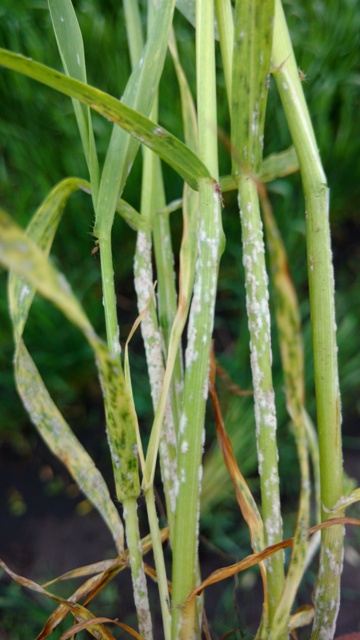Manitoba Insect & Disease Update
Issue 3: June 1, 2016
Summary
Insects: Cutworms and flea beetles on canola continue to be the insects of greatest concern. The cool, damp weather from the last few days would have slowed cutworm feeding, and the soil moisture, where not excessive, may help the plants compensate for feeding. Cutworm levels are quite variable, hard to find in some fields, more noticeable in others. So scout for potential cutworm feeding on emerging plants and dig for the larvae if you find an area that is showing signs of cutworm feeding. Precautionary insecticide applications, if cutworm levels are not economical, is not encouraged because of the potential damage to beneficial invertebrates.
Plant Pathogens: Rain has not only provided enough moisture for crops, but also for pathogens causing various crop diseases. Look for early signs and symptoms of diseases in crops. Scout! Scout! Scout!
Current Crop Diseases
Powdery mildew was reported in a winter wheat field in Carman area. Another winter wheat sample submitted to Manitoba Agriculture’s Crop Diagnostic Lab was also found to have powdery mildew.

Figure 1. Powdery mildew on winter wheat
Photo submitted by Dr. Andrew MacRae, Dow AgroSciences
No reports of stripe rust in Manitoba have been submitted as of today.
The wet conditions resulting from the ongoing rain could potentially favour disease development. Scouting will be important.
Wet Weather and Insects
Cutworms: With all the rain this week, some have been wondering what impact this may have on cutworms. Some species of cutworms are known to spend the day deeper in the soil when conditions are drier. So the cutworms may be closer to the soil surface with all this moisture. This may make them more vulnerable to predators and parasitoids. Wet soil conditions can also promote fungal diseases among cutworms.
Grasshoppers: We were starting to note the emergence of young grasshoppers last week. Excessive rains like these can be detrimental to the young grasshoppers that have emerged. However, grasshoppers that are still as eggs would be resilient to excessive moisture, even if the water pools on the soil.
Aphids: Very low levels of English grain aphid were noted on some of the winter cereals at the University of Manitoba Research farm the last couple of week in May, and some aphids were noted on winter wheat near MacGregor. Heavy rains can be detrimental to aphid populations.
Flea beetles (that feed on canola): There is no research studying the impacts of rainfall on populations of canola feeding flea beetles. Even after heavy rains, our experience has been that on hot, calm days that follow heavy rains the flea beetles are often back on the plants. So once the weather warms up again it is highly advised to scout canola in vulnerable stages for flea beetles.
Insects in Forage Crops
Young larvae of alfalfa weevil have been reported from alfalfa in eastern Manitoba. So alfalfa growers should start monitoring for alfalfa weevil.
Insect Monitoring Programs
Diamondback Moth: Some moths have been caught in the pheromone-baited traps, but levels so far have mainly been low, with the exception a few higher counts in the Northwest (Minitonas, The Pas, and Birch River). The highest count so far is 125 from a trap near Minitonas. Table 1 below summarizes the highest cumulative counts in Manitoba.
Table 1. Highest cumulative trap counts for diamondback moth adults over the trapping period May 1 to May 28, 2016.
| Location | Count |
|---|---|
| Minitonas | 125 |
| The Pas | 52, 32, 25 |
| Birch River | 48 |
| Rosebank | 28 |
| Beausejour | 22 |
A summary of diamondback moth monitoring in Manitoba, and more detailed interpretation, can be found at:
http://www.gov.mb.ca/agriculture/crops/insects/diamondback-moth-forecast.html Bertha armyworm: A reminder for those who will be setting up traps to monitor bertha armyworm moth levels that trap setup is during the week of June 5 to 11.
Compiled by:
John Gavloski, Entomologist Pratisara Bajracharya, Field Crop Pathologist
Manitoba Agriculture Manitoba Agriculture
Phone: (204) 745-5668 Phone: (204) 750-4248
To report observations on insects or plant pathogens that may be of interest or importance to farmers and agronomists in Manitoba, please send messages to the above contacts.
To be placed on an E-mail list so you will be notified immediately when new Manitoba Insect and Disease Updates are posted, please contact John Gavloski.
